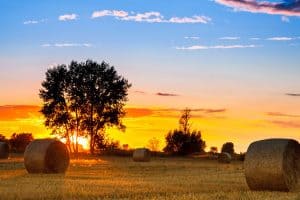It’s about 8 p.m. It is unseasonably cold in the Virginia mountains. I am sweating. I am also unseasonably cold…and cranky to boot. It has been raining softly but steadily for four hours. I am soaked down to the skin. It is dark. My moving parts are seizing up. I have had enough.
My rubber boots are muddy to their top, just below the knee. My hat has turned to a jellied drape. My glasses are fogged and splattered with rain. I have a heel blister. There’s water inside both boots, because I had to ford a high creek.
I am carrying about 50 pounds of barbed fence staples in each front pocket, a bag of aluminum fence ties, locking pliers in one back pocket, fencing tool in the other and a 20-ounce hammer. My jeans are about to fall around my ankles. My sodden, hooded sweatshirt is torn. I look like a convict who’s lost the chase through the swamp.
My hands are greasy with mud. They are scratched, pierced, and swollen to almost twice their normal size.
I am about half way through walking our fence line in anticipation of arriving cattle.
I do this each spring for one reason: If I don’t tack here and wire up there, some steer with too much random access will memorize the weakest spot in about two miles of boundary fence and lead a jail break one Sunday evening after I’ve gone to bed, even though the neighbor’s pasture is less green than that which the herd has just abandoned.
Cattle do this because they appreciate stand-up comedy of the kind I provide. The show resembles the Three Stooges herding the Marx Brothers.
Getting 100 or so cattle sorted, separated and back to where everyone belongs is a lot more bother than repairing fence. It requires coordinating people like my wife, who is not a herd dog by either birth or instinct, though she does have trail-boss tendencies.
Repairing fence after the cattle have broken through is always harder, more frustrating and more expensive than preventive maintenance of the kind that turns me into a drowned rat.
Were I President, I would send a used fence tool to every civil servant, every foreign leader, every media blowhard and every political opponent with a short note (just in case the beneficiary had never been responsible for livestock fence): It’s easier to fix a weak spot than a hole.
While I am cold, wet and grumpy, my hands are worse. They hurt from dozens of wire scratches and barb gouges. They’re losing their strength, and I’m losing my grip.
I’ve always found that hands reveal more than eyes. Hands don’t lie; they can’t be trained to look one way and be another.
Life stories are written on hands. I haven’t earned farmer hands, so my irregular fencing duties are always unpleasant.
The most arresting hands I’ve seen belonged to Eddie Blosson. He was in his early sixties when I knew him as a young and immature high school kid 50 years ago. He described himself as a jack-of-all-trades handyman, but that doesn’t do justice to all he knew or could do.
He had led a fast life during Prohibition. He told me he had worn spats and carried a pistol, though he never said exactly why on either count. His fingers played a mandolin with ivory pegs, which now hangs on my dining room wall. As I hung around while he worked, he talked to me about little stuff and big stuff. It seemed that he thought I was worth talking to.
Eddie was a lean fellow with deeply lined hands that work had made three times larger and stronger than they should have been. His fingers were both abnormally long and thick, and uncannily nimble. They had been places that mine would never visit, which he knew then and I never thought about until later. They did anything he wanted. I doubt that he thought much about them, except as tools to get a job done.
Over the years, I’ve seen hands like Eddie’s on truck mechanics, coal miners, loggers and farmers. Mine aren’t like that, one of the many consequences of too much college.
It’s easy to think that blue-collar knowledge lies in blue-collar hands. But the truth is that it lies in blue-collar brains, which tell hands what to do.
Our economy has mothballed millions of people who know how to use their brains to solve problems with their hands. Some economists see this as sloughing off unnecessary and out-of-date costs; others see it as a stupid waste of talent.
Most of the sweat on our collective brow now comes from stress and worry, not labor. Maybe it’s still useful to break a sweat repairing something before it fails.
Being handy is more than being handy. It’s knowing that an ounce of prevention is worth a pound of cure and a stitch in time saves nine—two excellent reasons why it makes sense to fix a fence before cattle get through, not after.
This content may not be used or reproduced in any manner whatsoever, in part or in whole, without written permission of LANDTHINK. Use of this content without permission is a violation of federal copyright law. The articles, posts, comments, opinions and information provided by LANDTHINK are for informational and research purposes only and DOES NOT substitute or coincide with the advice of an attorney, accountant, real estate broker or any other licensed real estate professional. LANDTHINK strongly advises visitors and readers to seek their own professional guidance and advice related to buying, investing in or selling real estate.







Curtis, its easy now for me to chuckle as I read your cow/fence episode! I know just how funny it is….after the fact; it sure isn’t humorous…during tho, is it? JimT